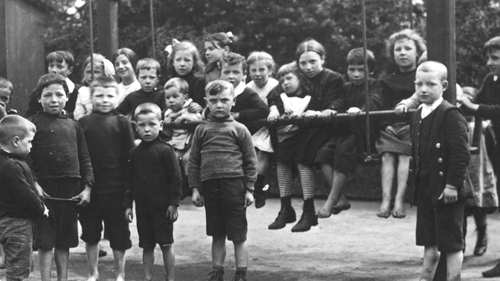Glasgow Green - Times Past

In partnership with the Glasgow Times, our archivists are exploring Glasgow's fascinating history. This week, Barbara Neilson writes about Glasgow Green.
Glasgow Green has been at the heart of so many public events over the years. The first one I ever attended was during the 1990s and was also my first visit to the Green. I lined up with thousands of other kids at the starting line of the Junior Great Scottish Run to race for the reward of a medal, a t-shirt and – best of all – a Tunnock’s Caramel Wafer.
Of course, every generation will have its own memories of public events at Glasgow Green. For many, each summertime brings to mind the carnivals and fairs held there throughout the years. Some will recall when the Green was used to host political speeches and demonstrations, though many of the fieriest gatherings are now beyond living memory. More recently, it’s been the venue for the city’s annual fireworks display. It became the Commonwealth Games Live Zone in 2014 and two years ago played host to the Euro 2020 Fan Zone.
The history of Glasgow Green is a long one. It’s the oldest park in the city, dating back to the mid-fifteenth century when King James II granted the land to William Turnbull, Bishop of Glasgow. He then gifted it to the people as common grazing land. The present-day Green owes its existence to Glasgow Town Council acquiring the land piecemeal between 1662 and 1792. Additional communal uses were found for it. Salmon fishers used it to dry their nets. Businesses and individuals used it to bleach linen. People hung their washing out to dry on it. Indeed, by 1741, a public wash-house (Glasgow’s oldest) had opened near the centre of the Green.
The Green wasn’t only a place for work, it was also a place for people to have fun. In previous centuries, there used to be a game of football every Shrove Tuesday. Rounds of golf were regularly played there and the Glasgow Golf Club built their clubhouse on the Green towards the end of the eighteenth century. The course itself featured seven holes but the names of five of these are now lost. The surviving names relate to physical features of the park. There was the Humane Society House Hole while the Monument Hole referred to the obelisk built in memory of Lord Nelson in 1806.
It was during the 19th century that the Green began to take the shape we’re familiar with today. The first carriage roads and paths were laid out to create a parkland and features such as monuments and drinking fountains were added including the Doulton Fountain in 1890. The People’s Palace, costing £18,000 to build, opened in 1898 in a formal ceremony presided over by the Earl of Rosebery.
It was towards the People’s Palace that I raced all those years ago, through the Green that has played host to centuries of public events and which has provided Glasgow’s people with so many opportunities for leisure and recreation in the heart of the city.
